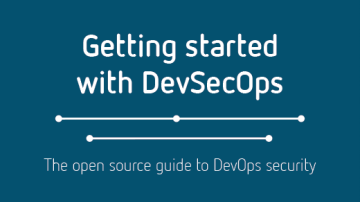“DevSecOps enables organizations to deliver inherently secure software at DevOps speed.” -Stefan Streichsbier
DevSecOps as a practice or an art form is an evolution on the concept of DevOps. To better understand DevSecOps, you should first have an understanding of what DevOps means.
DevOps was born from merging the practices of development and operations, removing the silos, aligning the focus, and improving efficiency and performance of both the teams and the product. A new synergy was formed, with DevOps focused on building products and services that are easy to maintain and that automate typical operations functions.
Security is a common silo in many organizations. Security’s core focus is protecting the organization, and sometimes this means creating barriers or policies that slow down the execution of new services or products to ensure that everything is well understood and done safely and that nothing introduces unnecessary risk to the organization.
[Download the Getting started with DevSecOps guide]
Because of the distinct nature of the security silo and the friction it can introduce, development and operations sometimes bypass or work around security to meet their objectives. At some firms, the silo creates an expectation that security is entirely the responsibility of the security team and it is up to them to figure out what security defects or issues may be introduced as a result of a product.
DevSecOps looks at merging the security discipline within DevOps. By enhancing or building security into the developer and/or operational role, or including a security role within the product engineering team, security naturally finds itself in the product by design.
This allows companies to release new products and updates more quickly and with full confidence that security is embedded into the product.
Where does rugged software fit into DevSecOps?
Building rugged software is more an aspect of the DevOps culture than a distinct practice, and it complements and enhances a DevSecOps practice. Think of a rugged product as something that has been battle-hardened through experimentation or experience.
It’s important to note that rugged software is not necessarily 100% secure (although it may have been at some point in time). However, it has been designed to handle most of what is thrown at it.
The key tenets of a rugged software practice are fostering competition, experimentation, controlled failure, and cooperation.
How do you get started in DevSecOps?
Gettings started with DevSecOps involves shifting security requirements and execution to the earliest possible stage in the development process. It ultimately creates a shift in culture where security becomes everyone’s responsibility, not only the security team’s.
You may have heard teams talking about a "shift left." If you flatten the development pipeline into a horizontal line to include the key stages of the product evolution—from initiation to design, building, testing, and finally to operating—the goal of a security is to be involved as early as possible. This allows the risks to be better evaluated, socialized, and mitigated by design. The "shift-left" mentality is about moving this engagement far left in this pipeline.
This journey begins with three key elements:
- empowerment
- enablement
- education
Empowerment, in my view, is about releasing control and allowing teams to make independent decisions without fear of failure or repercussion (within reason). The only caveat in this process is that information is critical to making informed decisions (more on that below).
To achieve empowerment, business and executive support (which can be created through internal sales, presentations, and establishing metrics to show the return on this investment) is critical to break down the historic barriers and siloed teams. Integrating security into the development and operations teams and increasing both communication and transparency can help you begin the journey to DevSecOps.
This integration and mobilization allows teams to focus on a single outcome: Building a product for which they share responsibility and collaborate on development and security in a reliable way. This will take you most of the way towards empowerment. It places the shared responsibility for the product with the teams building it and ensures that any part of the product can be taken apart and maintain its security.
Enablement involves placing the right tools and resources in the hands of the teams. It’s about creating a culture of knowledge-sharing through forums, wikis, and informal gatherings.
Creating a culture that focuses on automation and the concept that repetitive tasks should be coded will likely reduce operational overhead and strengthen security. This scenario is about more than providing knowledge; it is about making this knowledge highly accessible through multiple channels and mediums (which are enabled through tools) so that it can be consumed and shared in whatever way teams or individuals prefer. One medium might work best when team members are coding and another when they are on the road. Make the tools accessible and simple and let the team play with them.
Different DevSecOp teams will have different preferences, so allow them to be independent whenever possible. This is a delicate balancing exercise because you do want economies of scale and the ability to share among products. Collaboration and involvement in the selection and renewal of these tools will help lower the barriers of adoption.Finally, and perhaps most importantly, DevSecOps is about training and awareness building. Meetups, social gatherings, or formal presentations within the organization are great ways for peers to teach and share their learnings. Sometimes these highlight shared challenges, concerns, or risks others may not have considered. Sharing and teaching are also effective ways to learn and to mentor teams.
In my experience, each organization's culture is unique, so you can’t take a “one-size-fits-all” approach. Reach out to your teams and find out what tools they want to use. Test different forums and gatherings and see what works best for your culture. Seek feedback and ask the teams what is working, what they like, and why. Adapt and learn, be positive, and never stop trying, and you’ll almost always succeed.









1 Comment